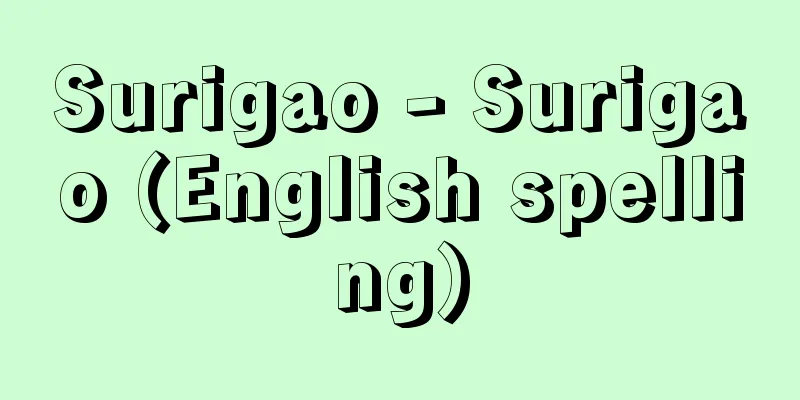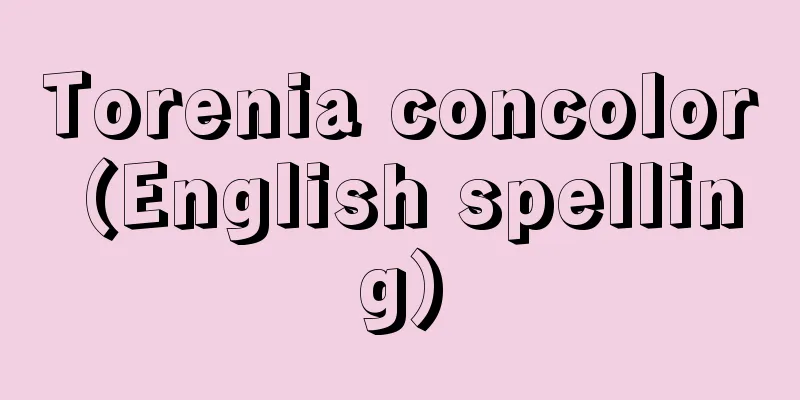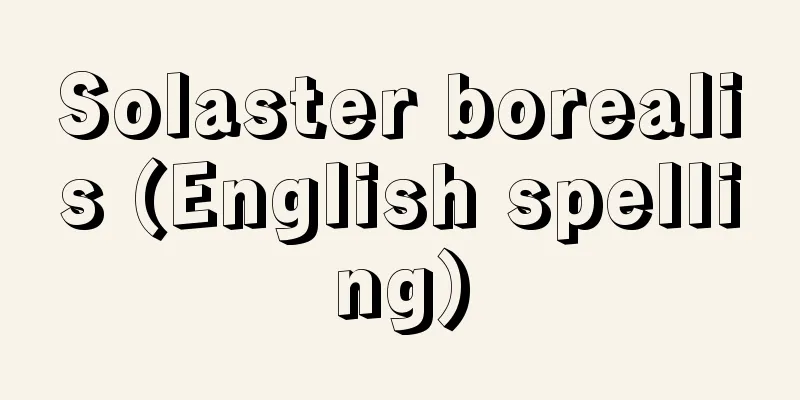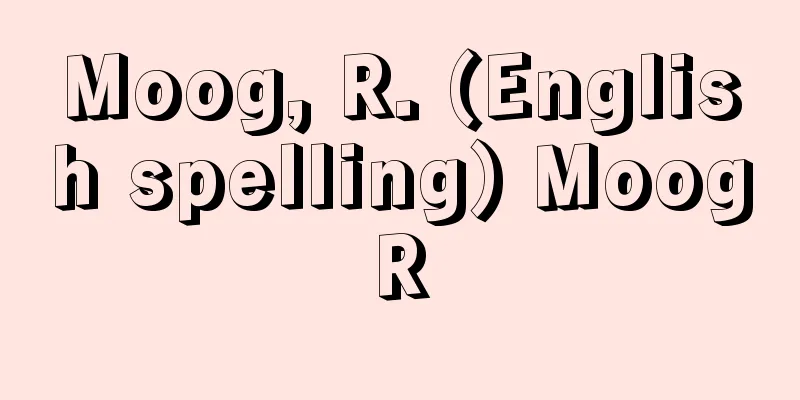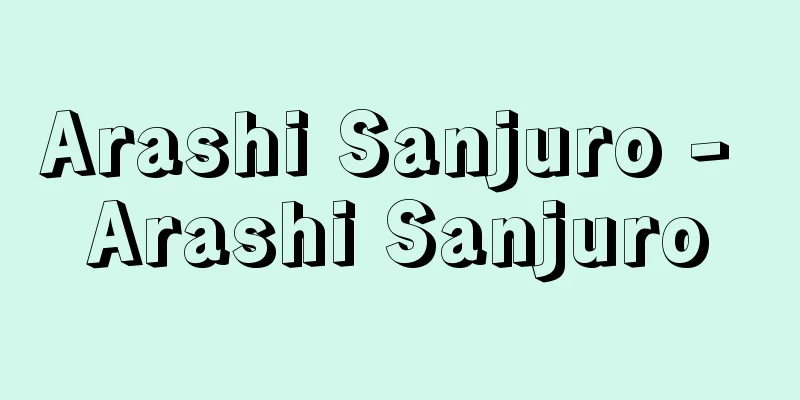Typewriter - typewriter
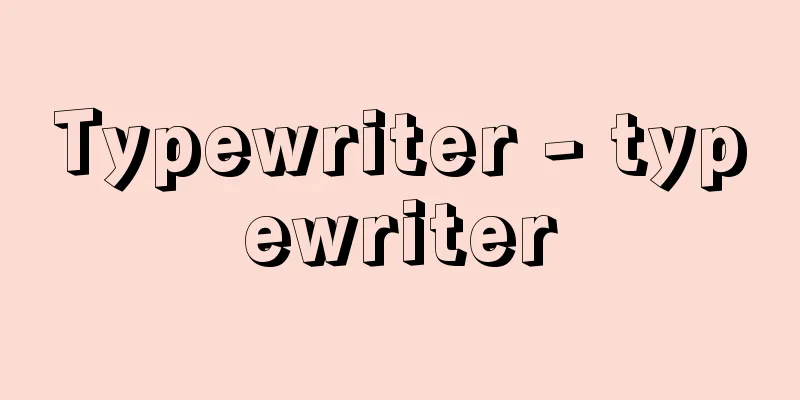
|
A writing machine that creates documents by pressing keys on a keyboard to print each character. There are Western typewriters, kana typewriters, and Japanese typewriters. Because it uses movable type, it is characterized by clear printing. [Kengo Iseya] European typewriterA typewriter that uses the phonetic characters of Europe and America, including the alphabet. [Kengo Iseya] historyThere is a record that Henry Mill of England obtained a patent for this in 1714, but the details are unknown. Over the next 150 years, more than 50 writing machine inventions were invented in Europe and America, with most notable being prototypes for use by the blind. From the 1850s, the number of inventions, particularly in America, increased, and by the 1870s, around 20 had been announced, but the operation was complicated and the printing speed was slow, and they were never put to practical use. Among these was the invention by Edison, which became the prototype for the tape printer for communication. The first practical typewriter was prototyped by American printing engineer Christoph Latham Sholes (1819-1890) with the backing of oilman James Densmore (1820-1889) and others, and was patented in 1868. Sholes invented around 30 prototypes over the next five years, and in 1873 commissioned Remington & Son, a New York manufacturer of guns, sewing machines, and agricultural machinery, to produce them. Remington purchased the patent rights, made improvements, and began selling them under its own trademark the following year, in 1874. The name "typewriter" is a proper noun that Sholes gave to his prototype machine, which later became a common name. [Kengo Iseya] structureThe most widely used typewriters have a traditional structure, consisting of (1) segments (40 or so type bars with 90 characters, two for the top and two for the bottom, fixed to the ends, arranged in a fan shape), (2) keyboard section (with keys connected to each type bar, a shift key for switching between the top and bottom characters, and other operating keys), (3) carriage section (which holds the paper and moves the printing position), and (4) auxiliary mechanism (the framework that connects each section and operates them in a related manner). When a key on the keyboard is pressed, the movement is transmitted to the related mechanism, the specified character is printed on the ink ribbon, and the carriage moves to the next printing position. This operation is repeated, and auxiliary operations such as line feed are added to create a document. There are a wide variety of models, from inexpensive, small, manual models to high-end office models. There are also electric and electronic portable models. Some models have electronic control mechanisms, store the print results, automatically print the required documents, and allow free proofreading and editing. Printing methods have also evolved from type bars to a spherical surface on which type is arranged and printed as the paper is moved along the surface, and some models have even arranged type on a disk-shaped comb, allowing for high-speed printing. Type has also changed from metal to synthetic resin for spherical and comb-shaped disks. Thermal transfer printing machines that produce no typing noise are now also available. Typewriters are indispensable for writing European languages, including English. Almost from the early days of Remington, the keyboard layout was standardized, and a touch method of operation without looking at the keys was established. Furthermore, the printing operation established by the typewriter has been inherited by the input method of advanced information processing devices and is becoming increasingly important. Western typewriters are widely produced in Europe, America, and other countries, and are also produced in Japan. [Kengo Iseya] Kana TypewriterMechanically, it is the same as a Western typewriter. It was invented in 1898 (Meiji 31) by Kurosawa Teijiro (1875-1953). It never gained much popularity because social customs made it difficult to create documents using only kana, and it has become almost unused ever since the appearance of Japanese word processors. The basic keyboard layout of the kana typewriter is also used in computer and word processor keyboards. [Kengo Iseya] Japanese typewriterA writing machine that creates documents by printing kanji and kana characters one by one. Today, this role has been handed over to Japanese word processors and personal computers, and the market has shrunk significantly. [Kengo Iseya] historyIn 1914 (Taisho 3), Kyota Sugimoto completed a prototype and obtained a patent in 1915. The following year, in 1916, a practical model was released by the Japan Writing Machine Company (now Canon Semiconductor Equipment Co., Ltd.). When it was first released, it was designed for vertical writing only, with a fixed spacing between characters, and the paper size was B5 size. However, it gradually became popular because it was simple in structure and operation, could produce clear documents that were easy for anyone to read by copying several sheets at the same time, and could also be used as a copy for plate making. Typists who operated it were also established as professionals, and became pioneers of career women. In the 1930s, it became a representative office machine, and improvements were made such as the ability to type vertically and horizontally, the ability to change character and line spacing in multiple stages, and the diversification of paper sizes. The number of models and manufacturers increased, but most of them disappeared as World War II intensified. After the war, as the economy recovered, demand grew and the number of manufacturers increased. One postwar trend was a polarization between high-performance models for specialist technicians and simple models for general use. Taking advantage of the clarity of the type printed, high-performance models were widely used not only for office use but also for plate making in the printing industry, and models with proofreading and editing functions linked to computers were also developed. As for general use, the small Japanese typewriter developed by Sugimoto Kyoji (Kyota's second son) in 1964 (Showa 39) became widely used as a low-cost model that was easy to operate. [Kengo Iseya] structureIt consists of a typeset, a main mechanism for operation and control, a section for inserting paper and allowing writing to take place, and a base and framework. While fewer than 100 characters are sufficient for Western languages, Japanese typewriters require several thousand characters. In addition, a method of categorizing and organizing the characters according to frequency of use, pronunciation, and character shape is required to quickly find the required character. (1) The typeset contains enough zinc type to type normal documents, and the remaining types are stored in separate boxes according to the system. The font is mainly Ming Dynasty. (2) The required character is then selected by operating the main mechanism. There are two types of typesetting: a direct type, where the type in the typeset is looked at directly, and an indirect type, where a character arrangement index board is used. When the print key is pressed, the typebar extracts the type, strikes the tape surface, and returns the type to its original position. There are two types: a type in which the main mechanism and typebar are fixed and move the typeset, and a type that moves the mechanism and typebar to pick up the type. The control is to set the character spacing, line spacing, and line spacing. There are many types of Japanese typewriters, differing by character arrangement method, whether electric or manual, whether vertical or horizontal typing, character and line spacing settings, typesetting, and other functions, and whether or not they are computer-controlled. They are also classified by purpose, such as general use, professional use, or specialized use. [Kengo Iseya] [Reference] | |Source: Shogakukan Encyclopedia Nipponica About Encyclopedia Nipponica Information | Legend |
|
活字を一字ずつ鍵盤(けんばん)を押して印字し、文書を作成する書記機械。欧文タイプライター、仮名タイプライター、和文タイプライターがある。活字を使用するため、鮮明な印字が得られるのが特徴である。 [伊勢谷堅吾] 欧文タイプライターアルファベットなど、おもにヨーロッパ、アメリカ諸国の表音文字を用いるタイプライター。 [伊勢谷堅吾] 歴史1714年にイギリスのヘンリー・ミルHenry Millが特許を得た記録があるが、詳細はわかっていない。その後、ヨーロッパ、アメリカでの書記機械の考案は150年間に50以上が数えられるが、盲人用としての試作が目だっている。1850年代から、ことにアメリカでの考案が増加し、1870年代までに約20件が発表されているが、操作が複雑で印字速度も遅く、実用には至らなかった。なかには通信用テーププリンターの原型となったエジソンの発明も含まれている。 最初の実用的タイプライターは、アメリカの印刷技術者ショールズChristoph Latham Sholes(1819―1890)が石油業者デンスモアJames Densmore(1820―1889)などの後援によって試作し、1868年に特許を得た。ショールズは以後5年の間に約30の試作機を考案し、1873年、ニューヨークの銃・ミシン・農耕機製造業者レミントン父子社に製作を依頼した。レミントンは特許権を買い取って改良を加え、翌1874年自社商標で販売を開始した。タイプライターという名は、ショールズが試作機に命名した固有名詞がのちに一般化したものである。 [伊勢谷堅吾] 構造もっとも多く使用されている伝統的な構造のタイプライターは、(1)セグメント(四十数本のタイプバーの先に上下2字、合計九十数字の活字を固定し、扇状に配列してある)、(2)鍵盤部(各タイプバーに連結するキーと、上下2字を使い分けるシフトキー、そのほかの作動キーが配列される)、(3)キャリッジ部(用紙を装着し印字位置を移動させる)、(4)補助機構(骨格部、各部分を結び関連作動させる)からなっている。 鍵盤部のキーを押すと、その動きが関連機構に伝達され、所定の活字がインキリボン面を打ち印字され、キャリッジが次の印字位置に移動する。この操作の反復に改行などの補助動作を加えて文書を作成する。 機種は安価な手動式小型から高級事務型まで多様である。携帯用機種にも電動や電子式のものがある。制御機構も電子化して、印字結果を記憶して自動的に所要文書を印字し、自由に校正・編集のできる機種もある。 印字方式もタイプバーから、球形の表面に活字を配列し、固定した用紙面を移動しながら印字する方式に発展し、さらに円板状の櫛(くし)歯に活字を配列し、高速印字が可能な機種もある。活字も球形や櫛歯円板では金属から合成樹脂製に変わった。さらに打字音のない熱転写印字式のものも販売されるようになった。 英語をはじめとするヨーロッパ諸語の表記に、タイプライターは不可欠である。レミントンのほぼ初期のころから鍵盤の配列も標準化し、キーを目視せずに操作するタッチメソードが確立されている。さらに、タイプライターによって確立された印字操作は、高度情報処理機器のインプット方式に継承され、重要度を増している。 欧文タイプライターは広くヨーロッパ、アメリカなど諸国で生産されており、日本でも生産されている。 [伊勢谷堅吾] 仮名タイプライター機構的には欧文タイプライターと同じである。1898年(明治31)黒沢貞次郎(ていじろう)(1875―1953)により創案された。仮名だけで文書を作成することが社会習慣上無理があるのでさほど普及せず、ことに日本語ワードプロセッサーの出現後はほとんど使用されなくなった。仮名タイプライターの鍵盤配列の基本は、コンピュータやワードプロセッサー鍵盤にも採用されている。 [伊勢谷堅吾] 和文タイプライター漢字と仮名の活字を一字ずつ印字して文書を作成する書記機械。現在、その役目を日本語ワードプロセッサーやパーソナルコンピュータに譲り、市場も大幅に縮小している。 [伊勢谷堅吾] 歴史1914年(大正3)杉本京太(きょうた)が試作機を完成し、1915年に特許を得た。翌1916年、日本書字機商会(現、キヤノンセミコンダクターエクィップメント株式会社)から実用機が発売されている。発売当初は字の間隔が一定の縦書き専用で、用紙もB5判大であった。しかし、構造も操作も簡単で、だれにも読みやすい鮮明な文書が複写によって同時に数枚つくれ、しかも製版の版下としても利用できるのでしだいに普及した。操作するタイピストも専門職として確立、キャリアウーマンの先駆けとなった。昭和10年代には代表的な事務機となり、縦横打ち併用、字間隔・行間隔多段変換、用紙サイズの多様化などの改良が行われた。機種、メーカーも増加したが、第二次世界大戦の激化とともに大部分が消滅した。 戦後、経済の復興とともに需要も伸び、メーカーも増えた。戦後の傾向としては、高性能専門技能者用と一般用簡便型の分極化がある。高性能型は、活字による印字の鮮明さを生かして事務用以外に印刷業での製版用としても多数使用され、さらにコンピュータと連動して校正・編集機能も備えた機種も実現した。操作が簡単で価格の安い一般用としては、1964年(昭和39)杉本京次(京太の次男)の開発した小型和文タイプライターが広く普及した。 [伊勢谷堅吾] 構造活字庫、作動と制御のための主機構部分、用紙を装着して書き進む部分、土台・骨格部分からなっている。 欧文は100に足りない文字で十分だが、和文タイプライターは数千字種が必要である。また、必要な文字を速く捜し出すための、使用頻度・音訓・字形などによる区分整理の方式が必要となる。(1)活字庫には普通の文書を打つのにほぼ十分な亜鉛活字を配列し、それ以外の活字は体系に従って別箱に収容してある。書体はおもに明朝(みんちょう)体である。(2)ついで主機構を操作して必要な字を選び出す。索字方式には、直接活字庫の活字を見て行う直視式と、文字配列見出盤による間接式がある。印字キーを押すと、タイプバーが活字を抜き出してテープ面を打ち、活字を定位置に戻す。主機構とタイプバーが固定されて活字庫を動かす方式と、逆に機構とタイプバーを移動させて活字を拾う方式がある。制御は字間隔・行間隔の送り、一行の字詰めなどを設定する。 和文タイプライターには、文字配列方式の違い、電動と手動、縦横打ち、字間行間設定、活字庫交換など諸機能の差、コンピュータ制御の有無などによって多くの種類があり、一般用、専門者用、特殊専用など用途によっても分類される。 [伊勢谷堅吾] [参照項目] | |出典 小学館 日本大百科全書(ニッポニカ)日本大百科全書(ニッポニカ)について 情報 | 凡例 |
>>: Godparents - Daifubo (English spelling)
Recommend
Ajimar Play - Ajimar Play
...In the local dialect, it is called Moashibi. M...
Pyongan Province (English spelling)
A region in the northwest of the Korean Peninsula....
Peccary - Peccary (English spelling)
A general term for animals in the family Peccarii...
Tripod - Tei
〘Noun〙① A metal vessel used in ancient China to bo...
Abitur
...Today, the pass rate for the baccalauréat is 7...
ṣarrāf (English spelling) sarraf
...However, for daily transactions and settlement...
Kaidenzu
…Today, the only surviving examples of rice field...
English Mothers - Mothers of England
…Furthermore, home economics books themselves cha...
Humid climate
According to W. P. Köppen, it is defined as a cli...
Discharge printing - Bassen
A method in which a paste liquid containing a dis...
Yezosukashi lily - Yezosukashi lily
...The Iwato-yuri L. maculatum Thunb. (illustrati...
Laminated glass - Laminated glass (English spelling)
A transparent film of butyral resin is sandwiched ...
Ono Tile Kiln - Onogayo
…a kiln built on the ground to bake tiles made fr...
Basic Guidelines for the Education of Working Youth
…Instead, towns and villages started educational ...
Ephyra
...Many constrictions form on the side of the pol...
